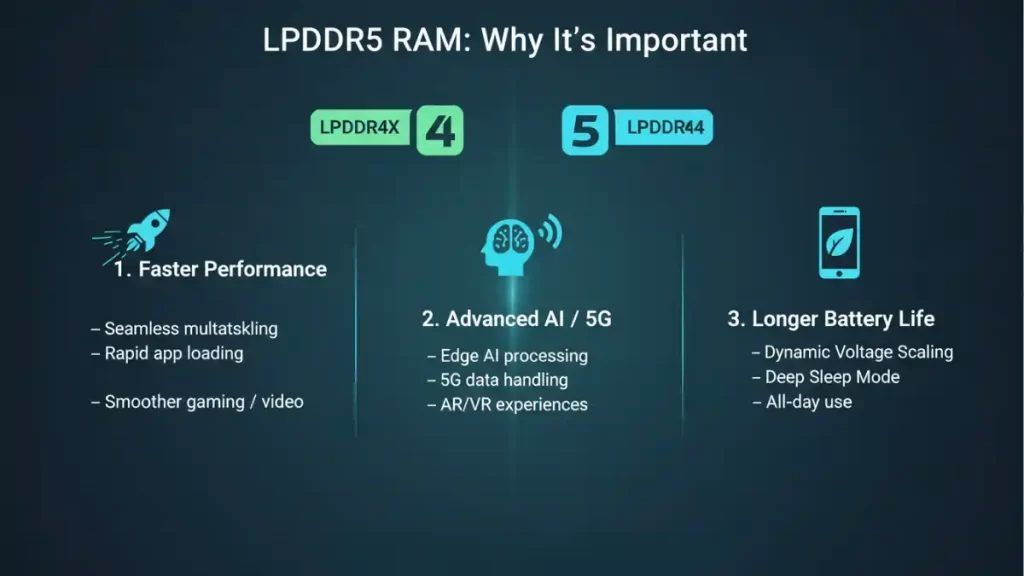
Definition: Low-power double data rate memory used in phones. LPDDR5 offers high bandwidth and lower power draw than older LPDDR generations, which helps with multitasking, gaming, and camera processing. Actual speed depends on the SoC memory controller and configuration.
What is LPDDR5?
LPDDR5 stands for Low Power Double Data Rate 5th generation. It’s a type of synchronous dynamic random-access memory (SDRAM) specifically designed for devices where power efficiency is crucial, such as smartphones, tablets, ultrabooks, and embedded systems.
Key Features and Improvements over LPDDR4X:
- Higher Speed (Data Rate):
- LPDDR4X typically offered speeds up to 4266 MT/s (mega transfers per second).
- LPDDR5 significantly boosts this, with initial speeds of 5500 MT/s and reaching up to 6400 MT/s. This means data can be moved much faster between the RAM and the processor.
- Increased Bandwidth:
- With higher speeds comes greater bandwidth. LPDDR5 can achieve bandwidths exceeding 50 GB/s (gigabytes per second), compared to around 34 GB/s for LPDDR4X. This is crucial for handling demanding applications, high-resolution video, and complex AI tasks.
- Improved Power Efficiency:
- Despite the speed increase, LPDDR5 is even more power-efficient. It introduces features like Dynamic Voltage Scaling (DVS), allowing the memory to operate at lower voltages when less performance is needed, thereby reducing power consumption.
- It also includes a new “Deep Sleep” mode for further power savings.
- Enhanced Reliability and Stability:
- LPDDR5 incorporates improved error correction features, leading to greater data integrity and system stability, which is vital for critical mobile applications.
Why is LPDDR5 Important?
- Enabling Faster Mobile Performance: With more powerful mobile processors and increasingly complex apps, LPDDR5 provides the necessary memory bandwidth to prevent bottlenecks. This translates to:
- Smoother multitasking
- Faster app loading times
- Improved gaming and video streaming experiences
- Supporting Advanced AI and 5G:
- Artificial Intelligence (AI): Many modern mobile devices perform AI computations directly on the device (“edge AI”). LPDDR5’s high bandwidth is essential for quickly processing the large datasets required for AI tasks like image recognition, natural language processing, and advanced camera features.
- 5G Connectivity: The super-fast data speeds of 5G require memory that can keep up. LPDDR5 ensures that data downloaded via 5G can be quickly accessed and processed by the device.
- Extending Battery Life: For mobile devices, every milliwatt saved is critical. LPDDR5’s enhanced power efficiency helps devices run longer on a single charge, providing a better user experience.
Where is LPDDR5 Used?
You’ll primarily find LPDDR5 in high-end and flagship mobile devices:
- Smartphones: The latest generation of premium smartphones heavily rely on LPDDR5 for their performance and power efficiency needs.
- Tablets: High-performance tablets benefit from the increased speed for productivity and entertainment.
- Ultrathin Laptops/2-in-1s: Some ultrabooks use LPDDR5 for a balance of performance and battery life in a compact form factor.
- Automotive Systems: Increasingly, advanced in-car infotainment and autonomous driving systems are adopting LPDDR5 for its reliability and performance.
- AIoT (AI + IoT) Edge Devices: Devices at the “edge” of networks that perform local AI processing often use LPDDR5.
In essence, LPDDR5 is a critical technology that underpins the performance, responsiveness, and battery life of modern portable electronics, enabling more powerful and intelligent mobile experiences.
Example: Switching between a game and camera without reloads thanks to ample LPDDR5.
Also called: LPDDR5
Related: UFS 3.1 storage, SoC
